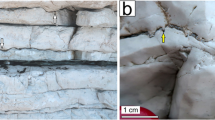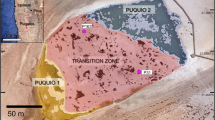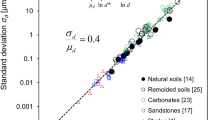Abstract
A protocol is described for separating sub-20μm-sized particles contained in sedimentary rocks into size fractions. Geochemical data from manually isolated foraminifera are commonly used in the interpretation of marine palaeoenvironments; problems associated with the isolation of calcareous nannofossils hampers their geochemical exploitation. However, geochemistry performed on calcareous nannofossil monotaxic assemblages should provide more meaningful data sets than those generated from the highly heterogeneous bulk carbonate. This protocol is based on cascade filtering steps, using polycarbonate membranes with well-calibrated pores. Strong ultrasonic treatment can further be applied to selectively reduce the size of particles for greater enrichment. Obtained residues frequently comprise near-monotaxic nannofossil assemblages. The application of this technique, which can be achieved within less than 2 days, has provided distinct fractions of coccoliths, calcareous dinoflagellate shells and also diagenetic monocrystals. This protocol is designed for application in reconstructing the history of water-column physicochemistry and diagenesis. It also has the potential to provide insights into the biogeochemistry of calcareous nannoplankton, including vital effects.
This is a preview of subscription content, access via your institution
Access options
Subscribe to this journal
Receive 12 print issues and online access
$259.00 per year
only $21.58 per issue
Buy this article
- Purchase on Springer Link
- Instant access to full article PDF
Prices may be subject to local taxes which are calculated during checkout







Similar content being viewed by others
References
Brand, U. Carbon, oxygen and strontium isotopes in Paleozoic carbonate components: an evaluation of original seawater-chemistry proxies. Chem. Geol. 204, 23–44 (2004).
Marshall, J.D. Climatic and oceanographic isotopic signals from the carbonate record and their preservation. Geol. Mag. 129, 143–160 (1992).
Zachos, J.C., Pagani, M., Sloan, L., Thomas, E. & Billups, K. Trends, rhythms, and aberrations in global climate 65 Ma to present. Science 292, 696–693 (2001).
Edwards, A.R. A preparation technique for calcareous nannoplancton. Micropaleontology 9, 103–104 (1963).
Katz, B.J. Preparation of calcareous nannofossils assemblages for chemical examination. J. Paleontol. 52, 497–500 (1978).
Eshet, Y. Obtaining rich nannofossils assemblages from 'barren' samples: processing organic-rich rocks in nannofossil investigation. J. Nannoplankton Res. 18, 17–21 (1996).
Green, O.R. A Manual of Practical Laboratory and Field Techniques in Palaeobiology (Springer Verlag, Berlin, 2001).
Paull, C.K. & Thierstein, H.R. Stable isotopic fractionation among particles in Quaternary coccolith-sized deep-sea sediments. Paleoceanography 2, 423–429 (1987).
Stoll, H.M. & Ziveri, P. Separation of monospecific and restricted coccolith assemblages from sediments using differential settling velocity. Mar. Micropaleontol. 46, 209–221 (2002).
Stoll, H.M. et al. Insights on coccolith chemistry from a new ion probe method for analysis of individually picked coccoliths. Geochem. Geophys. Geosyst. 8 10.1029/2006GC001546 (2007).
Minoletti, F., Gardin, S., Nicot, E., Renard, M. & Spezzaferri, S. Mise au point d'un protocole expérimental de séparation granulométrique d'assemblages de nannofossiles calcaires: application paléoécologiques et géochimiques. Bull. Soc. Géol. Fr. 172, 437–446 (2001).
Hermoso, M., Minoletti, F., de Rafélis, M., Rickaby, R. & Hesselbo, S.P. Uncovering high strontium content in biogenic calcite: new data from a murolith-producing coccolithophore. Eos. Trans. AGU. 88 Fall Meet. Suppl., Abstract B44C-05 (2007).
Hermoso, M., Minoletti, F., Rickaby, R.E.M. & Halloran, P. Determination of differential vital effects for some Neogene calcareous nannoplankton taxa. Geochimica Cosmochimica Acta. 72 (Suppl. 1): A371 (2008).
Minoletti, F., Hermoso, M. & Gressier, V. A new protocol to decipher the geochemistry of pelagic micron-sized particles: influence of bioproduction and diagenesis. Eos. Trans. AGU 87 Fall Meet. Suppl., Abstract PP12B-08 (2006).
Minoletti, F., Hermoso, M. & Gressier, V. Deciphering the Geochemistry of Calcareous Pelagic Producers: Beyond Bulk Carbonate Analyses. Eos. Trans. AGU 88 Fall Meet. Suppl., Abstract PP31C–0531 (2007).
Minoletti, F., de Rafélis, M., Renard, M. & Gardin, S. Remaniement des nannofossiles calcaires maastrichtiens dans les sédiments du Danien basal de Bidart (France): arguments isotopiques (carbone et oxygène). Rev. Micropaléontol. 47, 145–152 (2004).
Minoletti, F., de Rafélis, M., Renard, M., Gardin, S. & Young, J. Changes in the pelagic fine fraction carbonate sedimentation during the Cretaceous–Paleocene transition: contribution of the separation technique to the study of Bidart section. Palaeogeogr. Palaeoclimatol. Palaeoecol. 216, 119–137 (2005).
Beltran, C. et al. Coccolith δ18O and alkenone records in middle Pliocene orbitally-controlled deposits: high frequency temperature and salinity variations of sea surface water. Geochem. Geophys. Geosyst. 8 10.1029/2006GC001483 (2007).
Hermoso, M., Le Callonnec, L., Minoletti, F., Renard, M. & Hesselbo, S.P. Expression of the early Toarcian negative carbon-isotope excursion in separated carbonate microfractions (Jurassic, Paris Basin). Earth Planet Sci. Lett. (in press). DOI:10.1016/j.epsl.2008.10.013.
Lees, J.A & Minoletti, F. Separation of nannofossil size fractions by microfiltration: innovations, modifications, and results. 11th INA conference, Lincoln (Nebraska, USA), International Nannoplankton Association, Abstract volume 63 (2006).
Bairbakhish, A.N., Bollmann, J., Sprengel, C. & Thierstein, H.R. Disintegration of aggregates and coccospheres in sediment trap samples. Mar. Micropaleontol. 37, 219–223 (1999).
Stoll, H.M. Limited range of interspecific vital effects in coccolith stable isotopic records during the Paleocene-Eocene thermal maximum. Paleoceanography 20 10.1029/2004PA001046 (2005).
Dudley, W.C. & Goodney, D.E. Oxygen isotope content of coccoliths grown in culture. Deep-sea res., Part 1, Oceanogr. Res. PAP. 26, 495–503 (1979).
Dudley, W.C., Blackwelder, P., Brand, L. & Duplessy, J.C. Stable isotopic composition of coccoliths. Mar. Micropaleontol. 10, 1–8 (1986).
Ziveri, P. et al. Stable isotope 'vital effects' in coccolith calcite. Earth Planet. Sci. Lett. 210, 137–149 (2003).
Steinmetz, J.C. Stable isotopes in modern coccolithophores. In Coccolithophores (eds Winter, A. and Siesser, W.G.) 219–229 (Cambridge University Press, Cambridge, 1994).
Aubry, M.P. Late Paleogene calcareous nannoplankton evolution: a tale of climatic deterioration. In Eocene-Oligocene Climatic and Biotic Evolution (eds Prothero, D.R. and Berggren, W.A.) 272–309 (Princeton University Press, Princeton, 1993).
Chapman, M.R. & Chepstow-Lusty, A.J. Late Pliocene climatic change and the global extinction of the discoasters: an independent assessment using oxygen isotope records. Palaeogeogr. Palaeoclimatol. Palaeoecol. 134, 109–125 (1997).
Chepstow-Lusty, A. The last million year of the discoasters: a global synthesis for the upper Pliocene. In Microfossils and Oceanic Environments (eds Moguilevsky, A. and Whatley, R.) 165–175 (University of Wales Aberystwyth-Press, Aberystwyth, 1996).
Stoll, H.M. & Ziveri, P. Coccolithophorid-based geochemical paleoproxies. In Coccolithophores: From Molecular Processes to Global Impact (eds Thierstein, H.R. and Young, J.R.) 529–562 (Springer Verlag, Berlin, 2004).
Bellanca, A., Masetti, D. & Neri, R. Rare earth elements in limestone/marlstone couplets from the Albian-Cenomanian Cismon section (Venetian region, northern Italy): assessing REE sensitivity to environmental changes. Chem. Geol. 141, 141–152 (1997).
Westphal, H., Munnecke, A., Pross, J. & Herrle, J.O. Multiproxy approach to understanding the origin of Cretaceous pelagic limestone–marl alternations (DSDP site 391, Blake-Bahama Basin). Sedimentology 51, 109–126 (2004).
Munnecke, A., Westphal, H., Reijmer, J.J.G. & Samtleben, C. Microspar development during early marine burial diagenesis: a comparison of Pliocene carbonates from the Bahamas with Silurian limestones from Gotland (Sweden). Sedimentology 44, 977–990 (1997).
Keller, G. Depth stratification of planktonic foraminifers. In Miocene Ocean: Paleoceanography and Biogeography—GSA Memoir 163 (ed Kennett, J.) 177–195 (Geological Society of America, Boulder, 1985).
Acknowledgements
We are grateful to Maurice Renard (UPMC, Paris) for opening us the door of calcareous nannofossil separation in the JE 2477 'Biominéralisations et Paléoenvironnements' Research Group in Paris, and also to Nathalie Labourdette for her technical assistance in stable isotope analyses and Grégoire Egoroff (undergraduate research assistant) for monocrystal isolation. We warmly thank Ros Rickaby and Owen Green (Oxford University) for valuable improvements of an early version of this manuscript. This protocol also benefited from the helpful contributions of Jackie Lees, Jeremy Young, and an anonymous referee. F.M. was partly supported by UPMC action 'BQR2006' and M.H. by FNR/07/MA6/21.
Author information
Authors and Affiliations
Corresponding author
Rights and permissions
About this article
Cite this article
Minoletti, F., Hermoso, M. & Gressier, V. Separation of sedimentary micron-sized particles for palaeoceanography and calcareous nannoplankton biogeochemistry. Nat Protoc 4, 14–24 (2009). https://doi.org/10.1038/nprot.2008.200
Published:
Issue Date:
DOI: https://doi.org/10.1038/nprot.2008.200
This article is cited by
-
Eocene emergence of highly calcifying coccolithophores despite declining atmospheric CO2
Nature Geoscience (2022)
-
The uronic acid content of coccolith-associated polysaccharides provides insight into coccolithogenesis and past climate
Nature Communications (2016)
-
Silicon isotopes indicate enhanced carbon export efficiency in the North Atlantic during deglaciation
Nature Communications (2014)
-
Optical measurements to determine the thickness of calcite crystals and the mass of thin carbonate particles such as coccoliths
Nature Protocols (2014)
Comments
By submitting a comment you agree to abide by our Terms and Community Guidelines. If you find something abusive or that does not comply with our terms or guidelines please flag it as inappropriate.



